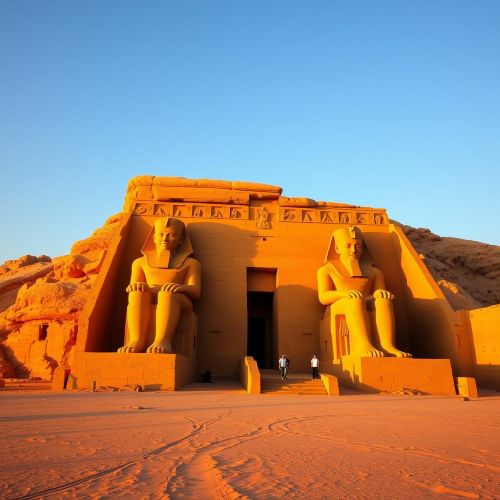
Abu Simbel : The Temple Complex
At a glance
| Description | |
|---|---|
| Mythology | Egyptian Mythology |
| Country | Egypt |
| Closest airport | Abu Simbel Airport (ABS) |
| Type | Constructed |
| Accessibility | 10/10 |
Introduction
Abu Simbel, an awe-inspiring archaeological site located in southern Egypt near the Sudanese border, captures the imagination with its colossal rock-cut temples and timeless desert backdrop. Built during the reign of Pharaoh Ramesses II in the 13th century BCE, this complex was intended not only to honor the gods but also to immortalize the pharaoh’s legacy. The grandeur and scale of Abu Simbel reveal the ancient Egyptians’ unmatched architectural ambition and deep spiritual beliefs. More than just a relic of the past, the site continues to be a magnet for history lovers, spiritual seekers, and travelers drawn to the mysteries of ancient Egypt.
Connection with Mythology
The spiritual importance of Abu Simbel is rooted in its alignment with key deities of ancient Egypt. The Great Temple pays homage to Amun-Ra, Ra-Horakhty, and Ptah—three major gods representing creation, the sun, and the underworld, respectively. The presence of a deified statue of Ramesses II among them underscores the belief that the pharaoh was not just a ruler but a divine entity.
A unique solar event at Abu Simbel adds a layer of mythical reverence. On just two mornings a year—February 22 and October 22—the sun pierces the temple’s inner sanctuary, illuminating all statues except that of Ptah, symbolically left in shadow due to his association with the underworld. These dates are believed to correspond with the king’s birthday and coronation day, further entwining cosmic cycles with royal divinity.
The nearby Small Temple, dedicated to Queen Nefertari and the goddess Hathor, stands out for its unusual artistic choices. Unlike most depictions in ancient Egypt, Nefertari is portrayed at the same scale as Ramesses II, suggesting a divine equality granted through her association with Hathor, the goddess of love and joy. The temple’s carvings and reliefs depict the queen in various sacred rituals, reinforcing her spiritual significance in the eyes of the ancient Egyptians.
Ways to Get There
Reaching Abu Simbel may seem daunting due to its remote location, but modern travel options make the journey relatively accessible. The most efficient route is by air, with daily flights operating from Aswan to Abu Simbel Airport. The flight takes less than an hour, followed by a short transfer to the site itself.
For those preferring a land-based adventure, private vehicles and organized bus tours from Aswan offer a scenic, three-to-four-hour drive across the desert. Though less convenient than flying, road travel allows for a more immersive experience of the Nubian landscape.
Another luxurious option involves cruising the Nile on a Lake Nasser cruise. These itineraries often include a stop at Abu Simbel, allowing visitors to approach the temples by water—an echo of how ancient Egyptians may have once traveled.
Public buses also operate from Aswan and are suitable for budget-conscious travelers. However, limited schedules may require an overnight stay in the village of Abu Simbel. Regardless of the mode of transport, the destination promises to be unforgettable.
What to Look For
Upon arrival, the sheer scale of the Great Temple leaves a lasting impression. Four seated statues of Ramesses II, each towering around 20 meters, guard the entrance. These figures, carved directly into the rock, are accompanied by smaller statues representing his family members, subtly emphasizing both personal legacy and divine right.
Inside the temple, intricate wall carvings tell stories of military triumphs, including the famed Battle of Kadesh, as well as religious ceremonies that highlight the king’s connection to the gods. The sanctuary at the end of the temple, where the famous solar alignment takes place, provides a profound moment for those visiting during the Sun Festival.
The Small Temple holds its own charm. Its façade features six statues—four of Ramesses and two of Nefertari—presented equally in size, a rare display of gender parity in ancient Egyptian art. Within, richly decorated columns and detailed reliefs depict the queen participating in divine rituals alongside Hathor, offering a glimpse into the fusion of royal power and goddess worship.
Make sure to also appreciate the surrounding landscape—Lake Nasser stretches in the background, a serene counterbalance to the stone colossi, and a reminder of the monumental relocation efforts that saved the temples from submersion.
Need a place to stay? Book your hotel room now!
Importance in cultural history
Abu Simbel is more than an archaeological wonder; it’s a symbol of human resilience and global unity. In the 1960s, Egypt’s construction of the Aswan High Dam posed a serious threat to the site. Rising waters from the newly formed Lake Nasser would have permanently submerged the temples. Recognizing their historical value, UNESCO launched a massive international campaign to save them.
Over four years, the temples were meticulously cut into large blocks, transported, and reassembled on higher ground, preserving their original orientation and celestial alignment. This unprecedented feat marked a turning point in heritage conservation, inspiring similar efforts worldwide to protect cultural treasures from modern development.
Beyond its dramatic rescue, Abu Simbel also speaks to Egypt’s efforts to extend its cultural influence southward into Nubia. The temples were a clear assertion of dominance, designed to impress and pacify local populations while reinforcing the divine mandate of Ramesses II’s rule.
Today, Abu Simbel remains one of Egypt’s most visited landmarks and a UNESCO World Heritage Site. It bridges ancient history with modern pride, standing as a monument not only to Egyptian civilization but also to global cooperation in preserving the past.
Best time to travel
Abu Simbel lies in one of the hottest parts of Egypt, so timing your visit is essential. The most pleasant months to explore the site are between October and April when the weather is cooler and more manageable for outdoor excursions. Temperatures during this period range from 15°C to 25°C (59°F to 77°F), making daytime exploration far more comfortable.
The highlight of the Abu Simbel calendar is the Sun Festival, held annually on February 22 and October 22. These dates mark the rare occurrence when the rising sun aligns perfectly to illuminate the temple’s sanctuary. These events draw large crowds, and accommodations in the area fill up quickly, so early planning is recommended.
For those looking to avoid the hustle of the festival season, visiting in the shoulder months of November or March offers a quieter yet still temperate experience. Early morning or late afternoon visits are ideal to catch softer lighting on the temples and avoid the midday sun.
Travelers willing to brave the heat during the summer months (May to September) will find fewer tourists and reduced prices, though temperatures can soar above 40°C (104°F). In such cases, hydration and sun protection become crucial.
Source
Julie. (2024). Abu Simbel: Everything You Need to Know to Plan Your Visit. https://www.earthtrekkers.com/how-to-visit-abu-simbel-day-trip/
Abu Simbel | History, Temples, Map, & Images | Britannica. (2025). https://www.britannica.com/place/Abu-Simbel
Contributors to Wikimedia projects. (2003). Abu Simbel – Wikipedia. https://en.wikipedia.org/wiki/Abu_Simbel
Gary Gold. (2023). Temple of Abu Simbel – GG Spiritual Maverick. https://www.ggspiritualmaverick.com/temple-of-abu-simbel/
Team Pilgrimaps. (2025). Abu Simbel: An ancient pilgrimage to the edge of the Egyptian empire. https://www.pilgrimaps.com/abu-simbel-an-ancient-pilgrimage-to-the-edge-of-the-egyptian-empire/
Jess Lee. (2023). Exploring Abu Simbel: A Visitor’s Guide – PlanetWare. https://www.planetware.com/nubia/abu-simbel-egy-asw-abusim.htm
Kholoud. (2025). Who Built Abu Simbel? The History Behind the Temples – visit Egypt. https://visitegypt.com/who-built-abu-simbel/
Frequently Asked Questions
Lorem ipsum dolor sit amet, consectetur adipiscing?
Lorem ipsum dolor sit amet, consectetur adipiscing elit. Praesent convallis vestibulum justo, ac tincidunt nunc vehicula quis. Nullam id dolor quis orci malesuada feugiat. Curabitur aliquet libero at urna ullamcorper, ac ultricies nulla dapibus.
Lorem ipsum dolor sit amet, consectetur adipiscing?
Lorem ipsum dolor sit amet, consectetur adipiscing elit. Praesent convallis vestibulum justo, ac tincidunt nunc vehicula quis. Nullam id dolor quis orci malesuada feugiat. Curabitur aliquet libero at urna ullamcorper, ac ultricies nulla dapibus.
Lorem ipsum dolor sit amet, consectetur adipiscing?
Lorem ipsum dolor sit amet, consectetur adipiscing elit. Praesent convallis vestibulum justo, ac tincidunt nunc vehicula quis. Nullam id dolor quis orci malesuada feugiat. Curabitur aliquet libero at urna ullamcorper, ac ultricies nulla dapibus.
Lorem ipsum dolor sit amet, consectetur adipiscing?
Lorem ipsum dolor sit amet, consectetur adipiscing elit. Praesent convallis vestibulum justo, ac tincidunt nunc vehicula quis. Nullam id dolor quis orci malesuada feugiat. Curabitur aliquet libero at urna ullamcorper, ac ultricies nulla dapibus.
Lorem ipsum dolor sit amet, consectetur adipiscing?
Lorem ipsum dolor sit amet, consectetur adipiscing elit. Praesent convallis vestibulum justo, ac tincidunt nunc vehicula quis. Nullam id dolor quis orci malesuada feugiat. Curabitur aliquet libero at urna ullamcorper, ac ultricies nulla dapibus.








